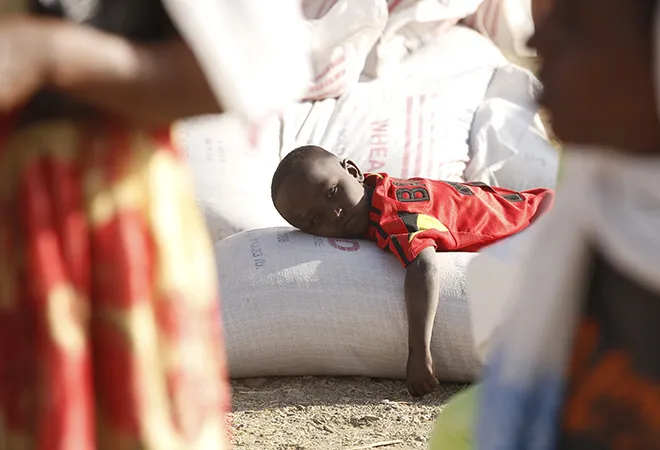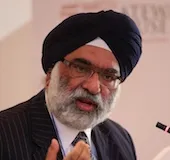
The African Union (AU) was born in 2002 as a successor to the Organisation of African Unity (OAU) as an effort towards uniting Africa. The AU was preceded by the New Economic Partnership for African Development (NEPAD); both presented a view of an Africa more in charge of its own destiny. The AU and
NEPAD were the transition from the anticolonial, anti-apartheid idiom of the OAU. The AU showed that in the 21
st century, Africa would deal with its own problems and seek a more equitable place in the world order.
The AU is an organisation of 50+ countries that has engaged its global partners with greater openness over the years. At OAU summits, a message from the Prime Minister of India used to be sent in solidarity with African nations. While the AU Indian delegations have participated in AU Summits on several occasions,
the Indian Minister of State for External Affairs was invited to address the ministerial segment of the 2011 summit. These summits became an arena of major participation by non-African countries, who saw it as an opportunity to meet almost all leaders of Africa at one time in one place.
For India, too, it was a major exercise to be able to interact with a large number of foreign ministers, particularly from countries where India had no diplomatic representation. Much of our Africa policy was discussed, elaborated and conveyed around AU summits.
If Nigeria and South Africa could persuade the AU to move beyond the Consensus, then a G6 for robust UN reforms could have emerged.
In 2005, India found a voice on the sidelines of two extraordinary summits of the AU where the
reform of the UN Security Council was discussed. The Ezulwini consensus, which bound Africa together on the issue of an inclusive Security Council, was sought to be amended with an initiative from Nigeria and more muted participation by South Africa. If Nigeria and South Africa could persuade the AU to move beyond the Consensus, then a G6 for robust UN reforms could have emerged. The Coffee Club countries like Egypt, Zambia and Zimbabwe
denied an amendment to the consensus. Here, India saw the diplomatic advantages of an AU summit. At later summits, India engaged with the committee of 10, meeting African leaders and ministers with greater ease than during a UN session in New York.
India undertook two initiatives in association with the AU in its early years. The
Pan African E network Project (PANEP) was implemented in 47 African countries and ran successfully for a decade beginning in 2009.This visionary project was enunciated by former President APJ Abdul Kalam in 2004 and a committee of the African Union Commission (AUC) and India led its formulation and implementation. The PANEP supported capacity building in education and medicine in Africa and contributed to decision-making
capacity within the AUC itself. This was never an easy task. There were many delays and crosscurrents as it was the first major project that any partner country had offered to do with the AU and it held high-value. The PANEP was the largest project outside the peace and security sector that the AU undertook at the time.
AUC Chairperson Alpha Konare was impressed by India’s progress, its democratic pluralism and openness as well as its successful model of cooperation with Africa, in which PANEP played a major role.
In 2006, at the Banjul summit, the AU decided to expand its partnerships with emerging countries and focused on India, Latin America and South Korea. This was to build upon existing partnerships that Africa had with Japan, the EU, France, China and the Arab League. India was the first choice for a new partnership;
the AU initiative for an India-Africa summit resulted from this decision as well as the visit of AUC Chairperson Alpha Konare to India in December 2006. Konare was impressed by India’s progress, its democratic pluralism and openness as well as its successful model of cooperation with Africa, in which PANEP played a major role. The Summit was feasible only because Konare proposed the participation of 15 African countries as per the Banjul Formula.
Due to these initiatives, the India-AU partnership became vibrant and robust leading to the
first India Africa Forum Summit (IAFS) in 2008, which was coordinated by the AUC. This model continued for
the second summit in Addis Ababa in 2011 under the Banjul Formula. This manner of collaboration with India became the model for the AU to work with other countries like Turkey, South Korea, the UK and subsequently Russia. They also used the India model to get themselves included as partners with regard to existing partnerships with Japan and China.
The IAFS provided an engagement with several countries with whom there had been rare interaction.
The IAFS process created a unique partnership with Africa at three levels. There was the AU level, the level of the Regional Economic Communities, and the traditional bilateral level. The IAFS provided an engagement with several countries with whom there had been rare interaction. The large number of projects offered through the IAFS covered all the regions, leading to India becoming a strong development partner. Lines of credits were enhanced through the summits; they took Indian business into many new countries normally away from Indian attention. India started to engage the trilateral partnership of the AU, the United Nations Economic Commission for Africa (UNECA), and the African Development Bank (AfDB).
Meetings with the Regional Economic Committees (RECs )were initiated.
However, the AUC did not live up to its expectation of being a strong implementing partner. Its decisions to award projects at the Pan-African level were political and not rooted in ground realities. It was
unable to enthuse many countries or RECS to implement their commitments. The implementation of the PANEP and the IAFS projects only succeeded where bilateral responses were stronger. Due to this, the AU fell out of favour as a development partner. It itself realised that ‘the AU’s complicated structure and limited managerial capacity leads to inefficient working methods, poor decision-making and a lack of accountability.’
The implementation of the PANEP and the IAFS projects only succeeded where bilateral responses were stronger.
The 2015 IAFS III moved away from the Banjul Formula and invited all the African countries, shifting gears to a more wholesome bilateral engagement. The RECs and the AUC were at a lower importance. This was also due to internal problems within
the AUC, whose election of officers became contentious and weakened its response systems. The AU was overwhelmed by the presence of partner delegations at their summits. Under revised rules by the
Kagame Committee in 2016, they decided not to invite partners to the AU summits, due to which Indian delegations stopped attending. India began opening 18 new missions in Africa between 2018 and 2021. Indian ministerial visits to African countries picked up rapidly. The importance of the AU summit, thus, diminished for Indian policy.
It is important for India to maintain the pan-African tier of engagement. Issues like terrorism, climate change, solar energy, globalisation, multilateralism, the WTO, blue economy and the like need to be discussed with the AU. It has avenues for discussion through arrangements with the ADB, NEPAD and the UNECA.
The Comprehensive Africa Agriculture Development Programme (CAADP), the
Program Infrastructure Development for Africa (PIDA) the African Medicina Agency (AMA) for medicines, and the high-five for specific infrastructure projects need regular partnerships. In dealing with the COVID-19 pandemic, a dialogue with the AU CDC is necessary. It would be useful to have an annual India-AU dialogue at the track 1.5 level, which will include government representatives, academia, business leaders and functional sectors of interest to both sides. These arrangements would lead to sector specific developments and invitations to join various efforts currently underway. An annual invitation to the President of the country which is to Chair the AU should also be instituted along with reviving a dialogue with the Chairperson of the AUC. This can be decoupled from the AU summits and held separately for emphasis.
It would be useful to have an annual India-AU dialogue at the track 1.5 level, which will include government representatives, academia, business leaders and functional sectors of interest to both sides.
The RECs could also be partnered with in a more robust fashion for the same purpose. Of the eight RECs, at least five are functioning well and a dialogue with them, which was
attempted in 2006, needs to be revitalised. Between 2008 and 2014, three
meetings with the RECs were held by India and these may be revived. The Indian Ambassadors located in countries where these have HQs should be formally asked to have periodic meetings; follow-ups to the decisions of these RECs should be instituted to see how their agenda and Indian interests can be better engaged. With the Africa Continental Free Trade Area (AfCFTA) now emerging,
India needs to engage with Africa at all levels — continental ,regional and bilateral—to ensure that its interests in issues like rules of origin and standards are not diminished.
As the preparations for IAFS IV are underway, there is need to reassess the relationship with the AU. The hiatus in the engagement was perhaps visible at
the midterm review in 2019. Not only was it delayed but it also seemed to lack a dialogue. Both sides said what they felt and neither seemed to be listening. The next summit, for instance, is being bounced between the two sides with the AU unilaterally allotting it to Mauritania, whose ability to hold such a large event is untested. A closer dialogue will obviate such hiccups.
The views expressed above belong to the author(s). ORF research and analyses now available on Telegram! Click here to access our curated content — blogs, longforms and interviews.



 The African Union (AU) was born in 2002 as a successor to the Organisation of African Unity (OAU) as an effort towards uniting Africa. The AU was preceded by the New Economic Partnership for African Development (NEPAD); both presented a view of an Africa more in charge of its own destiny. The AU and
The African Union (AU) was born in 2002 as a successor to the Organisation of African Unity (OAU) as an effort towards uniting Africa. The AU was preceded by the New Economic Partnership for African Development (NEPAD); both presented a view of an Africa more in charge of its own destiny. The AU and  PREV
PREV


